An array of 60 bishops of every colour filled Ulrich House, the Pastoral Centre of the Diocese of Augsburg in Bavaria. They gathered here at the invitation of the Catholic bishop of the city, Bertram Meier, on the occasion of the jubilee year with which the diocese is celebrating its patron saint: St. Ulrich.
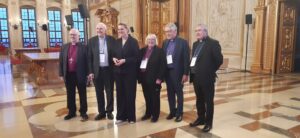
They came from every corner of the globe, from the Philippines, Indonesia, India and Pakistan to Finland and Sweden, from Madagascar, Burundi, South Africa and Uganda to Brazil, the USA and Venezuela, from Portugal, and Greec e and of course from Germany. Ireland was represented by Church of Ireland Archbishop of Armagh John McDowell, Bishop Brendan Leahy, Catholic Bishop of Limerick; Bishop Sarah Groves from the Moravian Church, Bishop Trevor Williams, former Church of Ireland Bishop of Limerick and Killaloe; Bishop Richard Clarke, former Church of Ireland Archbishop of Armagh. There were 27 nations in all, 29 the Churches represented attributable to the main confessions: Orthodox, Anglicans, Methodists, Evangelicals, Catholics of the Latin rite and of various Eastern rites. During the introductions, Bishop Trevor Williams, remarked, “Where on earth can you find such a meeting?”
But what binds together such a varied array of culture and tradition that is even manifested in the great variety of ecclesiastical clothing? It is the bold program that is announced in the title of the Conference: Dare to Be One. 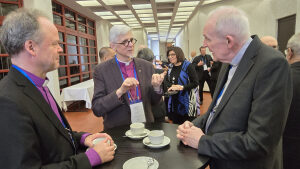 A call from Jesus to live the future, now. The coordinator of the Conference, Catholic Bishop Brendan Leahy, explained it in four “ecumenical imperatives”:
A call from Jesus to live the future, now. The coordinator of the Conference, Catholic Bishop Brendan Leahy, explained it in four “ecumenical imperatives”:
- Now take the initiative
- Now join us in the mission and go together to discover the “seeds of the Resurrection”
- Now recognize that any difficulty can become a launching pad
- Now love one another.
It is undoubtedly a counter-current program. It’s enough to think of the many dramatic situations from which these Bishops come and which they represent here.
The basis of the meeting is the spirituality of unity that offers strong incentives to implement what for some time has been called receptive ecumenism, an innovative approach that calls for putting ourselves in a position of learning from each other. This methodology is described by the Anglican theologian Callan Slipper, former ecumenical representative of the Church of England, who underlined the urgency of taking steps in this direction with an effective image: “It is as if we were one of those glittering stained glass windows of multicolored glass found in some churches. Because of our divisions, that rose window has split and its pieces have fallen and scattered on the ground. Each one is still beautiful, but each one lacks the splendour it would have if they were united. “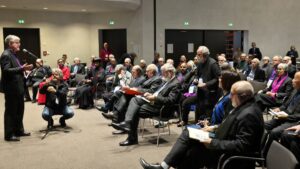
The participants of this meeting are committed to putting this window back together. “Nothing can prevent us from living here united in mutual love with great respect for each other,” observed Syriac Orthodox Metropolitan Theophilose Kyriakos, one of the ten bishops in the preparatory committee.
The thousand-year-old city of Augsburg was the setting for the Conference, the scene of key events of the Protestant Reformation: from Luther’s inconclusive talks with Card. Caetano in 1518 to the failure of a last attempt at agreement in 1530 with the Confession of Augsburg, today among the foundational documents of the Lutheran Churches; but also the Religious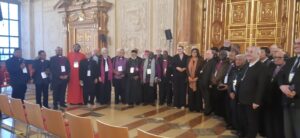 Peace achieved here in 1555 and the equality of the two confessions established in 1648, in the aftermath of the Thirty Years’ War; an event which, as the Mayor of the city Eva Weber reminded the bishops, during a reception in the Municipality, is still celebrated in Augsburg with the “Peace Festival” on 8th August.
Peace achieved here in 1555 and the equality of the two confessions established in 1648, in the aftermath of the Thirty Years’ War; an event which, as the Mayor of the city Eva Weber reminded the bishops, during a reception in the Municipality, is still celebrated in Augsburg with the “Peace Festival” on 8th August.
On Wednesday 28th another key event was commemorated in the evangelical church of Sant’Anna, this time an event of our times: the historic signing of the Joint Declaration on the Doctrine of Justification that took place on 31st October, 1999 in this church. On that day the Catholic Church and the Lutheran World Federation put an end to the main point of disagreement on which they had divided in the sixteenth century. Together with a beautiful group of faithful, the bishops recalled this step in a celebration that was as simple as it was touching. At the end when the assembly was reciting the Our Father, the noon bells rang out– just a coincidence?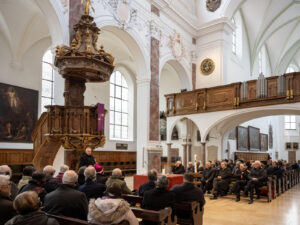
29 FEBRUARY 2024 by Hubertus Blaumeiser

